The ukulele is enjoying a surge in popularity. So if you're hoping to learn how to play it, you aren't alone!. That said, there are a lot of different types of ukuleles out there. Before you make your final choice, make sure you know at least a bit about ukulele types!
In this list, we'll take a look at the different types of ukulele as well as the various ukulele sizes you can choose from.
Ukulele Sizes And Types Of Ukuleles
The four main ukulele sizes are soprano, concert, tenor, and baritone. But the ukulele family extends beyond those four types. Though most ukes have nylon strings, different kinds can sound like different instruments. Ukulele tuning varies depending on size -- don't assume that two uke types have the same tuning!
Soprano Ukulele
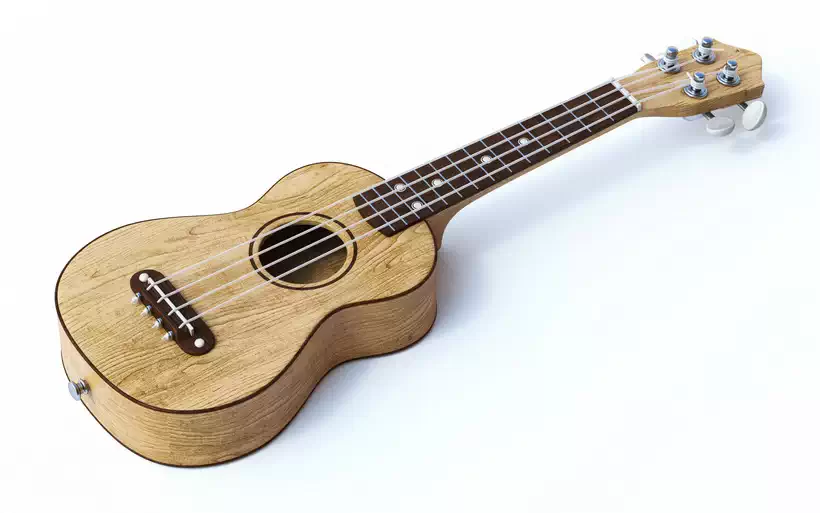
Soprano, concert, and tenor are standard uke sizes, but the soprano ukulele is probably the most popular. For many people, their first ukulele is a soprano uke. This traditionally shaped ukulele offers the classic, "plinky" ukulele sound.
Because of its small body, the soprano uke doesn't offer a whole lot of resonance. You'll most often hear it used for strumming. While it can be used for playing individual notes, the soprano ukulele has such a short scale length that it's limited to about 12-15 frets.
The soprano ukulele length is about 21" total, with a scale length of about 13"-14". Standard tuning is GCEA.
The soprano ukulele is often considered to be the standard uke for beginning players. As a bonus, its small size makes it an accessible choice for children. It's also advantageous for learning adults, as its small frets make it so they don't need to stretch their fingers far across the fretboard.
Check out this video to see and hear a soprano ukulele for yourself! The one in the video is a vintage Gibson uke from 1928.
Sopranino / Sopranissimo Ukulele
While not one of the traditional ukulele sizes, sopranino ukuleles, and sopranissimo ukuleles are worth looking into.
As you may have guessed from the name, sopranino and sopranissimo ukuleles are somewhat similar to soprano ukuleles. However, they are both smaller. A sopranino uke is about 19 inches long. A sopranissimo is usually about 17 inches. Both have about 10 frets.
A sopranino ukulele is usually tuned to DGEA, but it's a full octave higher than a typical baritone uke. These ukes can be called by a host of different names; you may hear them called "piccolo ukuleles," "pocket ukuleles," "tiny ukuleles," or "mini ukuleles."
The potential downside here is that sopranino or sopranissimo is going to have an even tinnier sound than a soprano ukulele. However, its small size makes it a great choice of travel instrument. This video shows you both sopranino and sopranissimo ukes.
Concert Ukulele
As another of the standard uke sizes, the concert uke is another popular choice. A concert size ukes give you a slightly fuller sound than the soprano and smaller instruments. It's also tuned the same (Video below left) way as a soprano uke, so players who can play one can play the other relatively easily.
A concert ukulele length is generally about 23 inches, and the scale length is about 15 or 16 inches. This size strikes a happy medium -- it's large enough that a concert ukulele has a somewhat warm, resonant sound. However, it's still small enough that it's easy to transport.
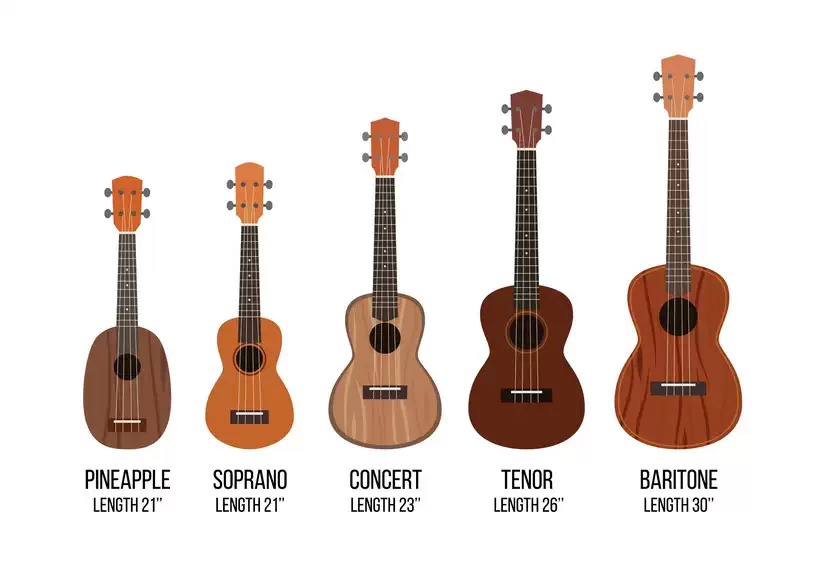
Though a lot of beginners start out with soprano ukes, many experts recommend concert ukuleles to people who want to learn to play ukuleles but don't have a strong preference as to size. For beginners with larger hands, concert ukuleles also tend to make learning easier.
A concert size uke is roughly between the sounds of a soprano uke (one of the most common sizes used by casual players) and a tenor uke (one of the most common sizes used by professionals).
Want to hear a concert ukulele? Check out this beautiful demo (video above right) of a Cordoba model.
Tenor Ukulele
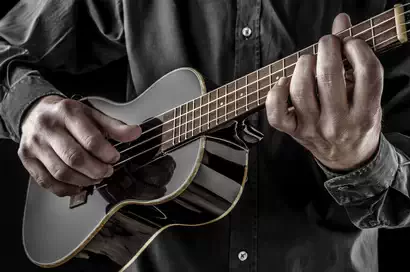
Many professional uke players prefer tenor ukuleles. A tenor uke offers a full dynamic range, and the frets are widely spaced enough to make complex fingerings a lot easier.
The tenor ukulele length is usually about 26 inches in total, with the scale length being 17-18 inches. That longer scale length gives you more frets, so performers have expanded options for playing both rhythm and lead.
Usually, a tenor ukulele uses GCEA tuning. But for an even lower sound, some performers opt for a "low G" tuning.
This demo lets you hear a beautiful solid mahogany tenor ukulele.
Baritone Ukulele
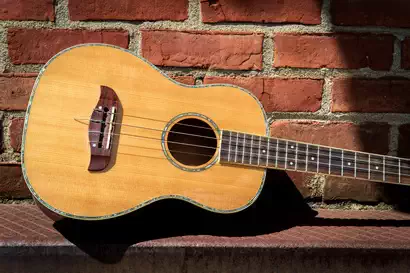
If you like the ukulele but want a deeper sound, look no further than the baritone ukulele. Thanks to its larger body and longer scale length, it's the most guitar-like of the ukes.
Interestingly enough, the baritone ukulele is tuned to DGBE -- the same tuning as a guitar's highest-pitched four strings. That tuning and the larger size make the baritone ukulele sound a bit like a brighter version of a nylon-string guitar.
The standard baritone ukulele length is about 30 inches in total (the scale length is about 19-20 inches). That length makes it a little less portable, but for fans of its rich and resonant sound, it's a worthwhile tradeoff.
Check out this cool video overview of baritone ukuleles to see if a baritone uke is right for you.
Pineapple Ukulele
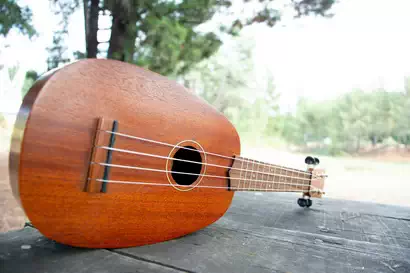
Pineapple ukuleles were invented in the 1920s, although they're still common today. The name comes from the fact that the ukulele body is shaped like a pineapple. However, it is attached to a traditional ukulele neck.
A pineapple ukulele will have the standard tuning (based on the size). Because the pineapple bodies don't have the pinched "waist" of a standard ukulele body, they tend to be louder and more resonant.
This video shows off a beautiful pineapple ukulele and its impressive, fuller sound.
8-String Ukulele
One of the other ukulele types you might want to consider is the 8-string ukulele. Soprano, concert, tenor, and baritone ukuleles can all come with eight strings.
You might think that learning to play an 8-string ukulele is a lot harder than learning to play a more typical model. But an 8-string uke is like a 12-string guitar: there are four sets of two strings. The tuning is the same, but you just get the jangly, chorus-y sound of a 12-string or a mandolin.
You can check out the intricate sound of an eight-string ukulele in this performance video.
Electric & Acoustic-Electric Ukuleles
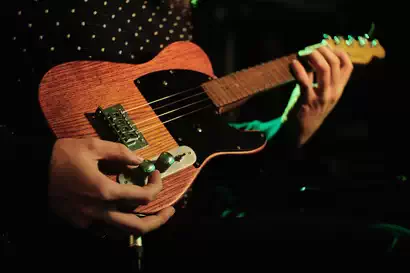
As you already know, most ukuleles have nylon strings. The same goes for semi-acoustic (or acoustic-electric) ukes. Like guitars, ukuleles can of course be equipped with pickups.
If you're looking for something that's a bit more non-traditional, the electric ukulele is worth a look! The electric uke is fashioned after the electric guitar, and many of them are designed to look like classic electric guitar models -- you likely noticed that the one in the picture looks a whole lot like a Fender Telecaster!
Electric ukes and acoustic-electric ukes can give you a louder sound that makes them perfect for live performance. And if you like to experiment with sound, you can use effects pedals with an electric uke just as you can with a guitar!
Not sure what an electric ukulele sounds like? Check out this cool demo of a Telecaster-style electric ukulele.
Resonator Ukulele
You may already be familiar with the unique sound (video below left) of the resonator guitar. A resonator ukulele is tuned just like a standard ukulele. But like a resonator guitar, it has aluminum cones within it resulting in a distinctive twangy, bluesy sound.
Resonator ukes are most commonly used in blues music. But their highly unusual sound makes them a good choice for sonic explorers or anyone who writes experimental music.
You might sometimes hear resonator ukes called "Dobro ukuleles," since "Dobro" has become a colloquial name for a resonator guitar. However, since "Dobro" is a trademark, these interesting little instruments are more properly called resonator ukuleles.
This cool video (above right) lets you see and hear a Gretsch resonator ukulele!
Archtop Ukulele
Do you love the sound of archtop guitars but feel called to play uke? If so, archtop ukes are right for you! Archtop ukuleles are one of the most unique of all the other ukulele types. Like archtop guitars, they are ideal for jazz -- they have a smooth sound with just enough "thump." And of course, they have the beautiful f-holes found on almost all archtop guitars. These ukes are almost always tenor-sized.
This video lets you see the jazz-inspired aesthetic of an archtop ukulele.
Bass Ukulele
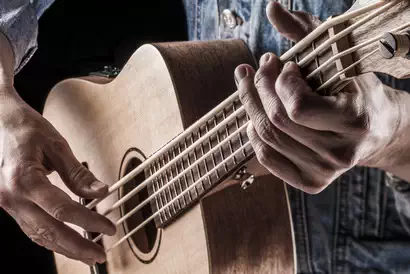
They may not have all the boom of upright bass, but bass ukuleles have a deeper sound than other uke types. Essentially, the bass ukulele is to the standard ukulele as the bass guitar is to the guitar.
Interestingly enough, a bass ukulele is tuned just like a bass guitar. But bass ukulele strings are even heavier than those on a bass guitar. That's because a bass ukulele has a much shorter scale length than a bass guitar, so it needs thicker strings to deliver an appropriately low tone.
This bass ukulele demo offers a great introduction to what bass ukes sound like.
Hybrid Ukuleles
From banjo ukes to the harp ukulele to a more familiar ukulele/guitar hybrid, hybrid ukuleles offer a break from your more traditional soprano, concert, tenor, and baritone ukes. Here are a few you might want to check out:
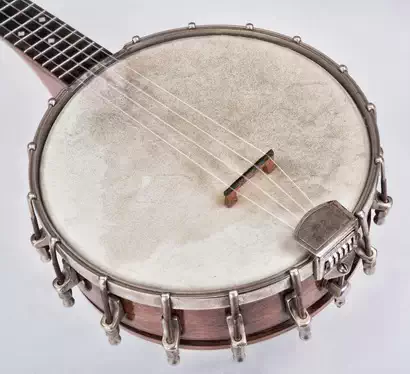
If you play guitar but still want to pick up the uke, a guitar ukulele (or "guitalele") is a good choice. Like a classical guitar, a guitar ukulele usually has nylon strings. Many of these instruments are tuned like guitars, so the sound is effectively between that of a ukulele and a classical guitar.
Perhaps the strangest of these uke types is the harp ukulele. These instruments are fairly rare now. But you'll know one when you see one -- a harp ukulele has an extended bridge that seems to arc over the neck.
This performance (video Below left) will give you a sense of what the harp ukulele can do.
Banjo ukuleles are another cool instrumental hybrid. A banjo ukulele is tuned just like a regular ukulele, but it has the signature body of a banjo. The banjo ukulele isn't just a gimmick; it was designed in the 1920s to convert the ukulele's signature sound to something louder and bolder.
Want to hear what a banjo ukulele sounds like? Check out this entertaining demo! (video below center)
While it's not technically a separate type, the cutaway ukulele is worth mentioning. Just like acoustic guitars, ukuleles can also have a cutaway (video above right) to allow better fretboard access.
Final Thoughts
Playing the ukulele is an exciting musical adventure! Whether you go with one of the standard ukulele sizes or choose something very unique, you're sure to have fun with this pleasant-sounding and highly portable little instrument.
What do you think? Which of the different types of ukuleles is your favorite? Let us know in the comments, and please like and share if you found this list useful!
